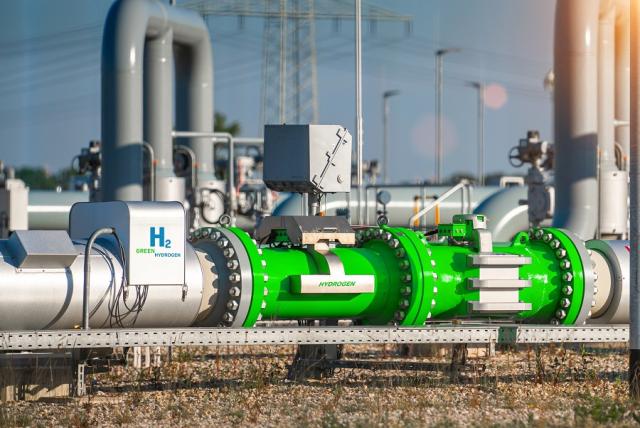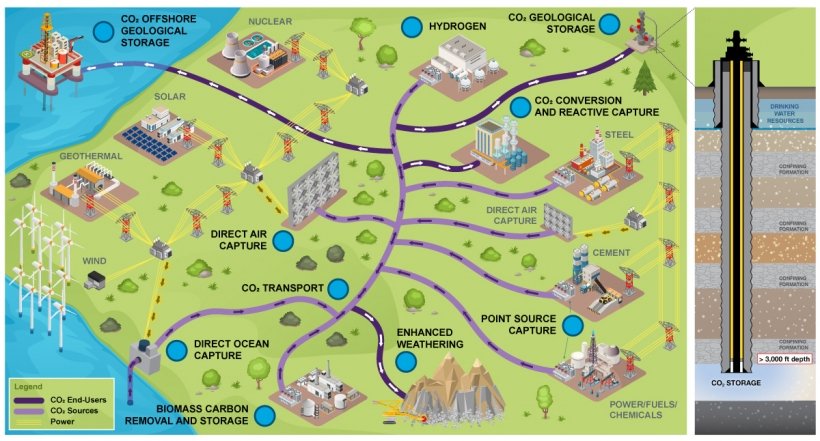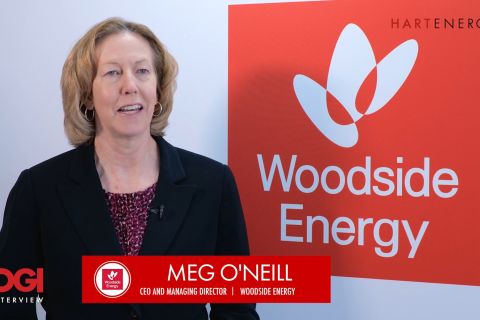
Midstream investments face an uphill battle over supply and demand dynamics, permitting headaches and a lack of direct CCS incentives. (Audio und werbung/ Shutterstock.com)
Learn more about Hart Energy Conferences
Get our latest conference schedules, updates and insights straight to your inbox.
Midstream operators have been invited to the green hydrogen party — and recent federal legislation could help them cash in on carbon capture and storage (CCS) — but whether they RSVP is complicated.
On Dec. 16 the U.S. Department of Energy (DOE) detailed its plans to spend $750 million under the Bipartisan Infrastructure Law “to dramatically reduce the cost of clean-hydrogen technologies.”
Together with the regional clean hydrogen hubs, tax incentives in the Inflation Reduction Act (IRA) and ongoing research, development and demonstration in the DOE Hydrogen Program, the new investments are intended to accelerate the technical advances and scale-up needed to achieve DOE’s goal of $1 per kilogram (kg) of clean hydrogen within a decade.
“DOE has been focused on hydrogen,” said Pamela Wu, a partner in the energy and project development practice group of law firm Morgan Lewis. “But there have been funding opportunities of which the CCS segment can take advantage. Most of those have been specific to things like technology innovation, but a few weeks ago DOE announced a significant funding opportunity for regional direct-air capture hubs to capture CO2.”

"In hydrocarbons, the pipelines have tended to be just that. Some midstream companies have invested in upstream or downstream, but most have stuck to midstream transportation." — Kirstin Gibbs, Morgan Lewis
Infrastructure will play a large role in the envisioned hydrogen future. But midstream investments face an uphill battle as the nascent sector deals with supply and demand questions and operators face continued permitting headaches. A lack of direct CCS incentives for midstream further muddies the waters.
DOE has encouraged collaboration among multiple parties, Wu added, “including developers, technology firms, manufacturers and academia. It is an exciting opportunity for the capture industry, in which midstream plays a central role.”
That central role in CCS is analogous to midstream’s role in hydrocarbon transport, but there is an important nuance, said Kirstin Gibbs, also a partner in the energy and project development practice group and co-leader of the energy industry team. "These new opportunities in CCS, hydrogen and low carbon energy projects often are not stand-alone transportation business models for pipeline companies. In hydrocarbons, the pipelines have tended to be just that. Some midstream companies have invested in upstream or downstream, but most have stuck to midstream transportation.”
Partners in CCS or hydrogen often have to be invested in the whole value chain, Gibbs added.
“That represents a different role for midstream operators and investors who have traditionally provided a transportation/storage only service. There are definitely great opportunities for midstream companies if they are willing to get fully involved.”
To help disseminate the hydrogen funding, DOE has a matchmaker website. Another site has been set up for CCS funding.
Midstream remains ‘unaware of opportunities’
Industrial-scale green hydrogen is “a real chicken-or-egg problem,” said Phil Lookadoo, partner in the energy practice at Haynes and Boone. “There need to be huge supplies of hydrogen to make it economical and effective for difficult-to-decarbonize industries to invest in the technology to use it as an alternate fuel.
“But no one is going to commit to invest in significant consumption technology without some assurance of supply, and no one is going to invest in production technology at the scale required without some assurance of demand.”
As the market is secured, transportation will be needed. Hydrogen can be moved in existing natural-gas pipes. Initially, methane and relatively small quantities of hydrogen can be mixed and consumed. “Shippers, marketers and carriers will likely find themselves buying, selling and transporting both natural gas and hydrogen for many years to come.”
That will particularly be true after natural-gas producers, processors and pipelines have reduced or captured methane leaks and emissions to near-zero to satisfy lifecycle greenhouse gas emissions rates, Lookadoo said. “Those measures will be required by their customers seeking to qualify for tax credits under the Inflation Reduction Act.”
The infrastructure law amended the Natural Gas Act to put hydrogen under the Federal Energy Regulatory Commission’s (FERC) jurisdiction, “and FERC could probably find a way to fit CO2 into its jurisdiction as well,” he said.

However, midstream operators and capital allocators have been frustrated by the legal and regulatory difficulties encountered as they try to build CO2 lines, or even convert existing lines to that purpose. “The Manchin federal permitting bill, if it is enacted, could expedite permitting and facilitate under- and unused pipelines from becoming stranded assets by being converted to CO2 transport,” said Lookadoo.
Legislation to overhaul permitting by U.S. Senator Joe Manchin (D-WV) most recently failed in a Dec. 15 Senate vote.
Lookadoo chided the industry for not being more proactive on its own. “Too many folks in the pipeline business remain unaware of the opportunities to get on the right side of a public policy and environmental issue,” he stated, such as facilitating CCS, but also improving their own current operations.
“Some producers have committed to being carbon neutral and having their emissions monitored by independent third-party verifiers,” said Lookadoo, “and pipeline companies can do that as well. For example, pneumatic devices that are activated by compressed natural gas and vent to the atmosphere can easily be replaced. Pipelines should have done away with those a long time ago.”
Not feeling the love
Based on the pipeline rate cases on which Lookadoo worked in the 1980s, fuel and loss percentages of 3% to 4% were not uncommon, he said. Today the technology to monitor, detect and fix leaks and other emissions is readily available and can help get emissions from midstream operations down to the level of 4 kg of CO2 equivalent per kg of hydrogen produced to be eligible for the full tax credit incentives available under the recently enacted IRA. “That is an opportunity to both make money and be on the good side of climate-change politics.”
Operators may also see opportunities for looped lines that run parallel to existing pipelines, Lookadoo said. “If they can get past some people’s defensiveness in opposing anything to do with hydrocarbons,” long-haul pipelines that are looped have the ability to transport gas with one or two lines, while using the other line(s) to transport CO2.

"DOE has been focused on hydrogen." — Pamela Wu, Morgan Lewis.
Another challenge for midstream companies and capital providers: how best to cash in on the tax credits for CCS? With the formal allocation of tax credit being focused on generation and sequestration, midstream is not feeling the love.
“There are multiple ways to negotiate the revenue benefits of tax credits from one side of a deal to the other,” said Lookadoo. “The negotiated rates for pipeline service can be increased by a percentage of the tax credits earned by a shipper. Or midstream operators or their affiliates may even consider becoming tax-equity investors in hydrogen or CCS projects. Those approaches are on one side of the ledger.”
On the other side, plenty of pipeline companies are looking at CO2 capture and transport as ideal, long-term growth opportunities for the pipeline sector even without tax credits for pipeline owners, Lookadoo advised.
“For themselves or for their customers, if the tax credits enable new shippers to capture CO2 and seek transportation service on gas pipelines to industries using it as a feedstock or for sequestration, that will provide a much-needed growth opportunity for the gas pipeline business,” he said. “If climate-related tax credits for new customers will increase throughput for pipelines and enable pipeline owners in the long term to avoid becoming stranded assets, that really has to be seen as extremely valuable to pipeline owners.”
Recommended Reading
Tech Trends: Halliburton’s Carbon Capturing Cement Solution
2024-02-20 - Halliburton’s new CorrosaLock cement solution provides chemical resistance to CO2 and minimizes the impact of cyclic loading on the cement barrier.
Exxon Versus Chevron: The Fight for Hess’ 30% Guyana Interest
2024-03-04 - Chevron's plan to buy Hess Corp. and assume a 30% foothold in Guyana has been complicated by Exxon Mobil and CNOOC's claims that they have the right of first refusal for the interest.
Petrobras to Step Up Exploration with $7.5B in Capex, CEO Says
2024-03-26 - Petrobras CEO Jean Paul Prates said the company is considering exploration opportunities from the Equatorial margin of South America to West Africa.
The OGInterview: How do Woodside's Growth Projects Fit into its Portfolio?
2024-04-01 - Woodside Energy CEO Meg O'Neill discusses the company's current growth projects across the globe and the impact they will have on the company's future with Hart Energy's Pietro Pitts.
NAPE: Chevron’s Chris Powers Talks Traditional Oil, Gas Role in CCUS
2024-02-12 - Policy, innovation and partnership are among the areas needed to help grow the emerging CCUS sector, a Chevron executive said.





